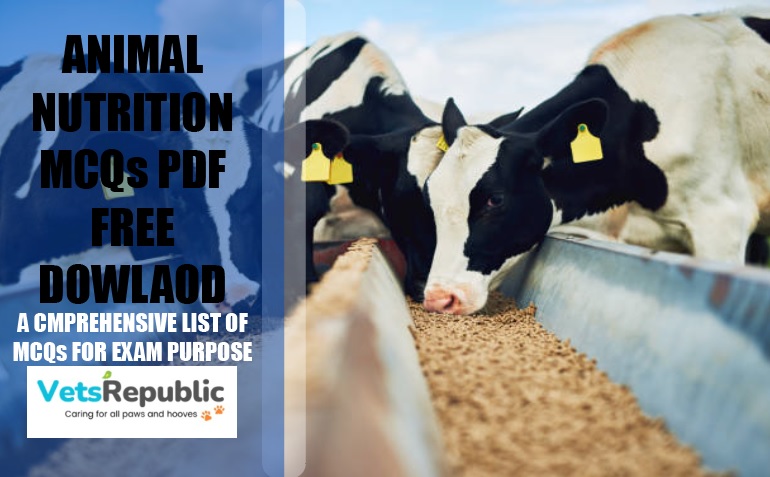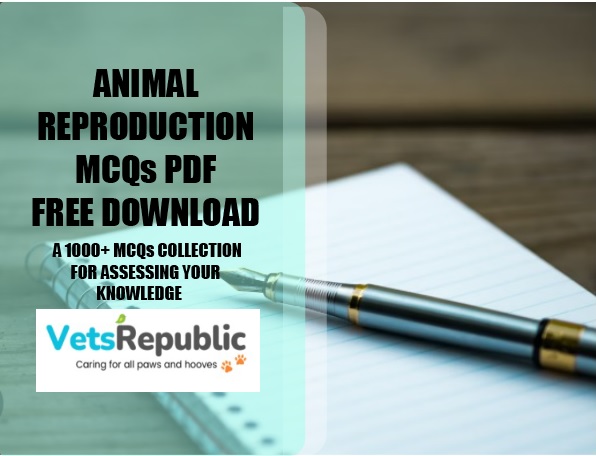Welcome to Vets Republic, your go-to educational hub for aspiring veterinary professionals. At Vets Republic, we provide comprehensive study materials and insightful articles tailored for students specializing in veterinary medicine. In this post, we will provide the link for Animal Reproduction MCQs PDF Free Download. Our platform aims to simplify complex concepts and offer valuable resources to aid your learning journey. Whether you’re diving into anatomy, pharmacology, or clinical practices, we’ve got you covered. Our commitment is to empower your education with accessible, high-quality content. In this post, we’ll be sharing the download link of Animal Reproduction MCQs PDF Free Download, ensuring convenience in accessing essential study materials. Join us at Vets Republic and embark on a seamless learning experience as you navigate the world of veterinary medicine. The PDF file contains over 1000 MCQs which will help you assess your knowledge in the respective topics.
Animal Reproduction MCQs Sample
1. Question: What is one of the most crucial factors determining the profitability of cattle production?
A) Animal Health
B) Feed quality
C) Reproduction
D) Genetic diversity
Answer: C) Reproduction
2. Question: What reproductive issues could render a cow’s other qualities irrelevant in cattle production?
A) Irregular feeding habits
B) Inability to graze efficiently
C) Failure in regular breeding activity and delivering healthy calves
D) Lack of genetic diversity
Answer: C) Failure in regular breeding activity and delivering healthy calves
3. Question: What technological approach has been suggested to potentially enhance the efficiency of cattle and buffaloes?
A) Improved feeding schedules
B) Controlled reproductive technology
C) Genetic modification of feed
D) Introducing new breeds
Answer: B) Controlled reproductive technology
4. Question: What is the estimated normal twinning rate in cattle?
A) 5-7%
B) 8-10%
C) 2-3%
D) 12-15%
Answer: C) 2-3%
5. Question: According to Guerra-Martinez et al. (1987), how much could twinning potentially increase the biological and economic efficiency of beef production?
A) 5-10%
B) 15-20%
C) 20-25%
D) 30-35%
Answer: C) 20-25%
6. Question: In what way could inducing twinning in dairy cows impact calf numbers in Ireland?
A) Decrease in calf numbers
B) No impact on calf numbers
C) Increase in calf numbers
D) Unpredictable impact on calf numbers
Answer: C) Increase in calf numbers
7. Question: Which country’s beef production systems might benefit significantly from having twin-bearing cows, especially in marginal areas?
A) USA
B) Australia
C) Ireland
D) EU countries
Answer: C) Ireland
8. Question: What is the approximate percentage of nutrients consumed by cows that go toward their maintenance?
A) 50%
B) 30%
C) 70%
D) 90%
Answer: C) 70%
9. Question: According to research in Northern Ireland, how can the adverse effects of twin-bearing on dairy cattle performance be minimized?
A) Reducing energy intake in late gestation
B) Accurate identification of twin-bearing cows in early pregnancy
C) Decreasing the overall feed intake
D) Limiting the gestation period of twin-bearing cows
Answer: B) Accurate identification of twin-bearing cows in early pregnancy
10. Question: Which research organizations in Australia have conducted studies on twinning in beef cattle?
A) Department of Agriculture in New South Wales
B) Department of Agriculture in Victoria
C) Commonwealth Scientific and Industrial Research Organization (CSIRO)
D) Western Australia Institute of Agriculture
Answer: C) Commonwealth Scientific and Industrial Research Organization (CSIRO)
11. Question: What has been estimated as the percentage of identical twins among like-sexed twins in cattle?
A) Less than 5%
B) Approximately 10%
C) Around 20%
D) More than 15%
Answer: B) Approximately 10%
12. Question: According to the text, what is a significant reason behind the natural reluctance of dairy farmers to increase the incidence of twins in their herds?
A) Increased calving intervals
B) Lower calf mortality
C) Higher culling rates
D) Improved reproductive performance
Answer: C) Higher culling rates
13. Question: How might planned management help avoid problems associated with twin calvings in dairy cattle, as suggested by Sreenan and Diskin (1992)?
A) Increased use of hormonal treatments
B) Enhanced calving supervision and feeding
C) Limiting access to grazing areas
D) Reducing overall herd size
Answer: B) Enhanced calving supervision and feeding
14. Question: In what range does the incidence of twin births usually fall among UK and Ireland cattle?
A) 5-7%
B) 8-10%
C) 2-3%
D) 12-15%
Answer: C) 2-3%
15. Question: Which factors are mentioned as influencing the twinning incidence in cattle?
A) Breed and age
B) Breed and geographical location
C) Environmental factors only
D) Geographical location and age
Answer: A) Breed and age
16. Question: What is the main reason for the occurrence of identical twins in cattle according to the text?
A) Hereditary factors
B) Environmental factors
C) Unknown reasons
D) Breeding techniques
Answer: C) Unknown reasons
17. Question: According to the text, what does Gordon (1983) suggest regarding beef cattle and twin pregnancy?
A) Cows handle twin pregnancy with considerable ease
B) Twin pregnancy poses more welfare concerns than singletons
C) Beef cows are not suited for twin pregnancies
D) Twin pregnancies lead to higher rates of dystocia
Answer: A) Cows handle twin pregnancy with considerable ease
18. Question: What range of twinning incidence was recorded in Holstein-Friesian dairy cows in Saudi Arabia?
A) 1-3%
B) 5-8%
C) 10-12%
D) 1-8%
Answer: B) 5-8%
19. Question: In what way could monozygotic twins be beneficial for biological experiments?
A) Introduce more variation
B) Decrease phenotypic expressions
C) Eliminate certain causes of variation
D) Increase the cost of experimentation
Answer: C) Eliminate certain causes of variation
20. Question: What is the opinion of Gordon (1983) regarding the welfare implications of substantially increasing the twinning percentage in beef cattle?
A) Twin pregnancies significantly impact cow welfare
B) Twin pregnancies have minimal welfare concerns
C) Twin pregnancies are inhumane for cows
D) Twin pregnancies result in higher mortality rates
Answer: B) Twin pregnancies have minimal welfare concerns
21. Question: According to the text, what is the frequency of twins in Holstein cattle over a 20-year period in Indiana?
A) 1.3%
B) 5.1%
C) 3-5%
D) 8-10%
Answer: B) 5.1%
22. Question: What did Robinson (1990) examine in relation to farm animal reproductive performance?
A) Targets set for reproductive performance
B) Environmental factors affecting reproduction
C) Genetic factors influencing reproduction
D) Nutritional needs during reproduction
Answer: A) Targets set for reproductive performance
23. Question: Which phrase describes the incidence of twins in cattle in isolated instances?
A) Extremely rare
B) Frequently occurring
C) Common occurrence
D) Regularly recorded
Answer: A) Extremely rare
24. Question: What was the reported incidence of twins in Black Pied dairy cattle in Germany according to Ernst et al. (1990)?
A) 3.23%
B) 2.31%
C) 5.77%
D) 0.05%
Answer: B) 2.31%
25. Question: Which hormonal treatment was used to induce multiple births in beef cattle in the 1959-61 field trial by the Milk Marketing Board in England and Wales?
A) FSH
B) LH
C) PMSG
D) Oxytocin
Answer: C) PMSG
26. Question: What was a major drawback of the PMSG treatment for inducing multiple births in cattle?
A) Low success rate
B) Marked individual variability
C) High cost of treatment
D) No effect on birth rates
Answer: B) Marked individual variability
27. Question: Which country reported using inhibin immunization to increase the ovulation rate in cattle?
A) Ireland
B) Australia
C) United States
D) Netherlands
Answer: A) Ireland
28. Question: What is the primary function of inhibins in the regulation of hormones in cattle?
A) Increase FSH secretion
B) Decrease LH secretion
C) Decrease inhibin concentrations
D) Enhance ovarian activity
Answer: B) Decrease LH secretion
29. Question: Which country experienced inconsistent field results due to excessive ovarian stimulation after inhibin immunization?
A) USA
B) Ireland
C) Australia
D) Netherlands
Answer: C) Australia
30. Question: What did studies on cattle follicular dynamics reveal about the emergence of multiple large follicles in twinning cattle?
A) No evidence of large follicles
B) Multiple large follicles in most follicular waves
C) Large follicles retained between waves
D) One large follicle per wave
Answer: B) Multiple large follicles in most follicular waves
31. Question: According to Gordon et al. (1962), what was suggested as a profitable approach to induce twinning using embryo transfer?
A) Bilateral two-embryo transfer
B) Transfer to previously bred recipients
C) Single-embryo transfer
D) Introduction of multiple embryos into the same horn
Answer: A) Bilateral two-embryo transfer
32. Question: What was the reported twinning rate in the largest twinning herd in the USA at Clay Centre, Nebraska, as per Morris (1994)?
A) 20%
B) 30%
C) 10%
D) 15%
Answer: B) 30%
33. Question: Which study demonstrated that a high incidence of twinning could be induced in the absence of a second corpus luteum?
A) Rowson et al. (1971)
B) Echternkamp and Gregory (1995)
C) Diskin et al. (1987a,b)
D) Gordon et al. (1962)
Answer: A) Rowson et al. (1971)
34. Question: What approach was suggested as a commercially feasible technique for producing twins in previously pregnant recipients based on Irish studies?
A) Artificial insemination
B) Embryo Transfer
C) Immunization
D) Ovarian stimulation
Answer: B) Embryo Transfer
35. Question: In which country were selection studies conducted for twinning in dairy cattle and the selection of bulls for the twinning trait?
A) Germany
B) France
C) New Zealand
D) Netherlands
Answer: A) Germany
36. Question: What was the average percentage of twin calving performance in the New Zealand herds as reported by Morris et al. (1991, 1992, 1993)?
A) 20%
B) 15%
C) 10%
D) 30%
Answer: B) 15%
37. Question: What conclusion was drawn about the economics of twinning by ET by Diskin and Hickey (1987)?
A) Cost-effective
B) Economically viable
C) Unlikely to be cost-effective
D) Highly profitable
Answer: C) Unlikely to be cost-effective
38. Question: According to Hanrahan (1983), what was the probability of embryonic survival to term in cattle in unilateral twin pregnancies compared to bilateral twin pregnancies?
A) 22% higher
B) 22% lower
C) Equal
D) 50% higher
Answer: B) 22% lower
39. Question: What did Echternkamp and Gregory (1995) observe regarding the emergence of multiple large follicles in cattle selected for twinning?
A) Large follicles were retained between waves
B) No evidence of large follicles
C) Multiple large follicles in most follicular waves
D) One large follicle per wave
Answer: C) Multiple large follicles in most follicular waves
40. Question: What was suggested by Gordon et al. (1962) as a potential profitable method for inducing twinning using embryo transfer?
A) Single-embryo transfer
B) Bilateral two-embryo transfer
C) Transfer to previously bred recipients
D) Introduction of multiple embryos into the same horn
Answer: B) Bilateral two-embryo transfer
41. Question: According to Morris (1994), where was the largest twinning herd located, reporting a twinning rate of about 30%?
A) France
B) New Zealand
C) USA (Clay Centre, Nebraska)
D) Germany
Answer: C) USA (Clay Centre, Nebraska)
42. Question: Which study successfully demonstrated the production of twins by bilateral two-embryo transfer?
A) Diskin et al. (1987a,b)
B) Rowson (1971)
C) Gordon et al. (1962)
D) Echternkamp and Gregory (1995)
Answer: B) Rowson (1971)
43. Question: What was suggested as a potentially cheaper approach compared to twinning by ET in terms of increasing ovulation rate?
A) Hormonal treatments
B) Immunization
C) Selective breeding
D) Natural breeding methods
Answer: B) Immunization
44. Question: What is the primary determinant for the success of the single-embryo transfer technique in cattle twinning?
a) Accurate heat detection
b) Use of bulls with high fertility
c) The recipient cow’s own embryo location
d) Ovulating ovary’s association with the uterine horn
Answer: c) The recipient cow’s own embryo location
45. Question: Studies have shown higher embryo survival rates in cows when the transfer is made to which uterine horn?
a) The horn associated with the ovulating ovary
b) The contralateral horn
c) Both horns simultaneously
d) The ipsilateral horn
Answer: a) The horn associated with the ovulating ovary
Animal Reproduction MCQs PDF Free Download
You might also be interested in:
Animal Nutrition MCQs With Answers PDF Free Download [Direct Link]

The Vets Republic website has initiated its journey to convey information that is useful for the veterinarian audience. Anything that we have published here is just for educational purposes. We have not posted any copyrighted content Your continuous support would be highly appreciated.
Disclaimer

This blog post is just for educational purposes and to convey important information to our audience. The content that we are publishing on our website is not collected or plagiarized from any source. We are just sharing our experience If anyone finds a text that is plagiarized from any source in our articles, please send us an email at Rizqum789@gmail.com and we will remove it within 24 hours.

